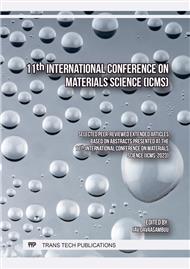[1]
Sivarama Krishnan, Marcel Mudrich, Intense laser matter interaction in atoms, finite systems and condensed media: recent experiments and theoretical advances, The European Physical Journal Special Topics vol 230, pages3981–3988 (2021)
DOI: 10.1140/epjs/s11734-021-00364-x
Google Scholar
[2]
Hong-Bin Yao, Zhao-Han Zhang, Chen-Xi Hu, and Feng He, Multiphoton excitation and ionization of hydrogen atoms in two-color laser fields, Phys. Rev. A 108, 043112 – Published 23 October (2023)
DOI: 10.1103/physreva.108.043112
Google Scholar
[3]
Xiao-Min Tong, A three-dimensional time-dependent Schrödinger equation solver: an application to hydrogen atoms in an elliptical laser field, Journal of Physics B, Phys. 50, 144004
DOI: 10.1088/1361-6455/aa77a0
Google Scholar
[4]
Collins L.A, Merts A.L (1990) "Atoms in strong, oscillating electric fields: momentum-space solutions of the time-dependent, three-dimensional Schrödinger equation "J.Opt.Soc.Am. B 7, 647
DOI: 10.1364/josab.7.000647
Google Scholar
[5]
Xiaoxin Zhou and C.D. Lin (1990) "Linear-least-squares-fitting procedure for the solution of a time-dependent wave function of a model atom in a strong laser field in the Kramers-Henneberger frame " Phys. Rev Lett 64, 862
DOI: 10.1103/physreva.64.043403
Google Scholar
[6]
Su.Q, Eberly.J.H, Javanaien.J (1990) "Dynamics of atomic ionization suppression and electron localization in an intense high-frequency radiation field" Phys. Rev. Lett 64 862
DOI: 10.1103/physrevlett.64.862
Google Scholar
[7]
Reed.V.C, Burnett .K (1990) "Ionization of atoms in intense laser pulses using the Kramers-Henneberger transformation" Phys, Rev A 42, 3152
DOI: 10.1103/physreva.42.3152
Google Scholar
[8]
Eberly J.H, Javanainen.J and Su .Q, (1989) "High-order harmonic production in multiphoton ionization"J.Opt. Soc.Am B 6 1289
DOI: 10.1364/josab.6.001289
Google Scholar
[9]
Schneider.B.I (1997) "Accurate basis sets for the calculation of bound and continuum wave functions of the Schrödinger equation" Phys, Rev A 55, 3417
DOI: 10.1103/physreva.55.3417
Google Scholar
[10]
Gavrila .M, Shertzer.J (1996) "Two-electron atoms in superintense radiation fields: Dichotomy and stabilization" Phys, Rev A 53, 3431
DOI: 10.1103/physreva.53.3431
Google Scholar
[11]
Guichard R, Bachau H , Cormier E, Gayet R and Rodriguez V.D (2007) "In-depth analysis of Coulomb-Volkov approaches to ioization and excitation by laser pulses" Phys.Scr. 76 397-409
DOI: 10.1088/0031-8949/76/4/020
Google Scholar
[12]
Jeremy M. Hutson, (1994) "Coupled channel methods for solving methods for solving the bound state Schrodinger equation" Computer Physics Communications 84(1994),1-18
DOI: 10.1016/0010-4655(94)90200-3
Google Scholar
[13]
Landau, L. D., Lifshitz, E. M. (1974) "Quantum Mechanics, Non-Relativistic Theory", Teoreticheskaya Fizika III, Moscow
Google Scholar
[14]
Frank Grossman(2008) "Theoretical Femtosecond Physics"
Google Scholar



